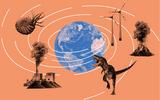MEK – K4 T1 I1 – A swamp full of monsters
Dragonflies as large as magpies. Millipedes you’d rather not run into: in the Carboniferous period, many organisms grew to a huge size. It was hot and humid, and life proliferated.
Conditions were ideal for swamp dwellers. Plants such as clubmosses and horsetails – unspectacular today – towered overhead, their stems several metres thick. It was the golden age of amphibians, which dominated the swamp forests.
Also lurking in the swamps were the first reptiles – including ancestors of mammals, and thus also of human beings.
For us, this is an alien world, but its abundant life is directly linked to the present: the luxuriant forests ultimately became the coal we burn today.
The forests of the Carboniferous are unique in the history of the Earth. It was only during this period that whole continents were covered by such luxuriant vegetation.
Over millions of years – with the aid of chlorophyll, sunlight and carbon dioxide CO2 from the air – the plants stored immense amounts of carbon C in their leaves and stems.
Dead plants sank into the swamps, where they were buried in sand and clay left by floodwaters. The remains of the plants turned into peat and then coal. We have been burning these coal deposits since the beginning of the industrial age. The greenhouse gas CO2 from primeval plants is thus returned to the atmosphere.
Animals and plants grew to giant proportions in the Carboniferous swamps: for these organisms, it was paradise on Earth.
Plants that are knee-high today, such as horsetails and clubmosses – a member of the lycopsid group, which at that time included scale trees – reached a height of over 30 metres. Conditions for these life forms were ideal: no competitors, permanently humid, with high temperatures and high concentrations of atmospheric CO2.
In addition, concentrations of oxygen O2 were almost twice as high as they are today, with large amounts being produced and little consumed by the enormous forests. This probably also explains the presence of gigantic dragonflies and millipedes: more oxygen meant more energy for growth and movement.
Well-preserved tree bark, leaves, seeds or spores – for example, from fern-like plants or scale trees – contain vast amounts of information on the life and death of the green giants.
Fossils of this kind, and many others, reflect the unfamiliar and diverse plant life of the swamps.
From swamp forest to coal-fired power station: scale trees were often the most abundant plants in the Carboniferous period – many coal deposits consist largely of the remains of these plants.
The carbon dioxide CO2 released when coal is burned stems from this tropical paradise – an environment inhospitable for human life.
A primeval forest of this kind also stood where the Swiss Alps tower today: in 2004, during the construction of the Lötschberg base tunnel through the Bernese Alps, fossilised plants from the Carboniferous period were discovered. Many of them were horsetails like this one, though not as large.
→ Objects in the floor display case
Unexpected relatives were also to be found in the monster swamp: this lizard-like creature already contained the seeds of human evolution.
Haptodus looks like a reptile, but – as our ancestor – it already has some features in common with later mammals. This can be seen, for example, in the structure of its teeth and skull.
The millipedes almost 3 metres long look as if they’ve come straight out of a horror film. But if you encountered one today, there’d be nothing to be afraid of!
The largest arthropod of all time was not a predator. With its short legs, it crawled slowly through the swamp forest, nibbling on plant litter.
Under water, hiding among the roots of giant plants, or lurking in thickets, a fearsome creature preyed on anything that came its way.
This amphibian, up to 4 metres in length, captured its prey with its huge mouth, brimming with sharp teeth – reminding us of a modern-day crocodile.
- A: Clubmoss, Lepidodendron (scale tree ), 35 m tall, in wall showcase
- B: Giant dragonfly, Meganeura, a persistent predator, wingspan 0.7 m
- C: Millipede, Arthropleura, a harmless herbivore, 2.6 m long
- D: Horsetails, calamites, 30 m tall, in wall and floor showcase
- E: Clubmoss, Sigillaria, 30 m tall, in wall showcase
- F: Haptodus, an ancestor of modern mammals – including humans – 1.5 m long
- G: Amphibian, Pholiderpeton, a carnivore, 4 m long
- H: Fern-like plants, 10 m tall, in wall and floor showcase
- J: Reptile, Hylonomus, an insectivore, 0.2 m long
Like all inhabitants of the Earth, we humans are inextricably bound up with the history of our home, this planet.
We have evolved, over an inconceivably long period, from a series of astonishing ancestors – in most cases, the relationship is not immediately obvious. Shown here are just a few important stages in this process.
Discover our astonishing relatives!
- Human
-
Homo sapiens
170 cm
ab 0.3 Mio. Jahre
Holozän
- Early monkey
-
Aegyptopithecus
60 cm
38-29 Mio. Jahre
spätes Eozän – frühes Oligozän
- Early primate
-
Purgatorius
20 cm
65 – 57 Mio. Jahre
Paleozän
- Early mammal with placenta
-
Eomaia
15 cm
130 – 125 Mio. Jahre
frühe Kreide
- Early mammal
-
Morganucodon
11 cm
220 – 170 Mio. Jahre
späte Trias – mittlerer Jura
- Mammal-like reptile
-
Dimetrodon
350 cm
300 – 272 Mio. Jahre
frühes Perm
- Mammal-like reptile
-
Haptodus
150 cm
310 – 285 Mio. Jahre
spätes Karbon – frühes Perm
- First animal with “spine”
-
Myllokunminigia
2.8 cm
525 – 520 Mio. Jahre
frühes Kambrium
- Early single-celled organism
-
0.0001 – 0.00001 cm
Ab 3'600 Mio. Jahre
frühes Präkambrium
